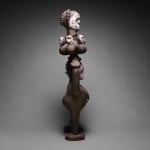Idoma Wooden Figure, 1850 CE - 1930 CE
wood
height 114.9 cm
height 45 1/4 in
height 45 1/4 in
DA.418
Further images
doma art in Western collections primarily consists of wooden masks which are used at funerals and for social control and of anthropomorphic wooden figures that may often be quite large....
doma art in Western collections primarily consists of wooden masks which are used at funerals and for social control and of anthropomorphic wooden figures that may often be quite large.
History: Linguistic evidence suggests that the Idoma have lived in their present day region for at least four to five thousand years, and that they probably moved into the area from the north along with the forbearers of Yoruba, Bini, and Igbo peoples sometime before that. All of these peoples belong to the Kwa family of languages, and linguists are able to estimate separation times based on the differences in their individual languages. They broke off of one of the larger ethnic groups in the area at some point in the distant past and began developing their own culture in relative isolation from their parent group.
Economy: Most Idoma are farmers. Their staple crops are yams and taro, known locally as cocoa yams. Harvesting is a time for great celebration. Yams are produced efficiently enough to export them to their neighbors. They also harvest the fruit of the oil palm which is processed into oil and exported to Europe in large quantities, making it a fairly profitable cash crop. Other crops of importance include maize, manioc, peppers, peanuts, tomatoes, squash, and sweet potatoes. Goats, sheep, chickens and dogs are kept by nearly everyone. Although hunting no longer provides a substantial contribution to the local economy, fishing has remained very important throughout the region.
Political Systems: The Idoma may live in compact villages or in relatively dispersed family homesteads. Political ties exist primarily on the community level with a headman, or chief, who inherits his position along patrilineal lines. Royal succession among the Idoma often alternates between two patrilineal lines, to some extent weakening the power of the ruler. The chief usually consults a council of elders before making any important decisions. In the past, age-grade societies and the related masking traditions contributed to social control.
Religion: Idoma religion focuses on honoring lineage ancestors. Funeral ceremonies among the Idoma are often quite dramatic, with greater attention afforded to members of the community who have reached a combination of advanced age and prestige. Extensive funerals are held for both women and men in preparation for sending them on their final journey away from the village to the spirit world across the river. A memorial service, or second burial, is held for the deceased some time after the original burial in order to ensure that the dead pass on to the ancestor world in proper style.
History: Linguistic evidence suggests that the Idoma have lived in their present day region for at least four to five thousand years, and that they probably moved into the area from the north along with the forbearers of Yoruba, Bini, and Igbo peoples sometime before that. All of these peoples belong to the Kwa family of languages, and linguists are able to estimate separation times based on the differences in their individual languages. They broke off of one of the larger ethnic groups in the area at some point in the distant past and began developing their own culture in relative isolation from their parent group.
Economy: Most Idoma are farmers. Their staple crops are yams and taro, known locally as cocoa yams. Harvesting is a time for great celebration. Yams are produced efficiently enough to export them to their neighbors. They also harvest the fruit of the oil palm which is processed into oil and exported to Europe in large quantities, making it a fairly profitable cash crop. Other crops of importance include maize, manioc, peppers, peanuts, tomatoes, squash, and sweet potatoes. Goats, sheep, chickens and dogs are kept by nearly everyone. Although hunting no longer provides a substantial contribution to the local economy, fishing has remained very important throughout the region.
Political Systems: The Idoma may live in compact villages or in relatively dispersed family homesteads. Political ties exist primarily on the community level with a headman, or chief, who inherits his position along patrilineal lines. Royal succession among the Idoma often alternates between two patrilineal lines, to some extent weakening the power of the ruler. The chief usually consults a council of elders before making any important decisions. In the past, age-grade societies and the related masking traditions contributed to social control.
Religion: Idoma religion focuses on honoring lineage ancestors. Funeral ceremonies among the Idoma are often quite dramatic, with greater attention afforded to members of the community who have reached a combination of advanced age and prestige. Extensive funerals are held for both women and men in preparation for sending them on their final journey away from the village to the spirit world across the river. A memorial service, or second burial, is held for the deceased some time after the original burial in order to ensure that the dead pass on to the ancestor world in proper style.







